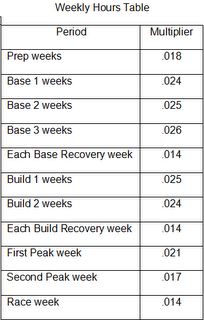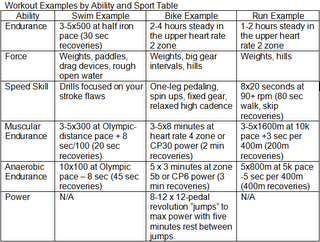Preparing for the 2010 Season, Part 5
This is the last installment on how to prepare your Annual Training Plan (ATP) as you start thinking about the 2010 season. While I've been doing periodized planning for nearly 30 years now I realize that many see it as overly detailed and analytic. There's no doubt that it goes well beyond what most athletes are willing to do. If you are satisfied with your current level of race performance then this is not necessary. Just continue doing what you've been doing. But if you have set high goals for yourself I guarantee you that long-range planning will make those goals easier to achieve.
You’ve now got most of the ATP complete and have a general idea of what you will do in training. What remains are the specifics including setting the number of hours you will work out weekly—your volume. Once volume is determined you’re ready to take care of the final details—the actual workouts.
In your copy of The Triathlete’s Training Bible go to Table 7.2. In The Cyclist’s Training Bible it is Table 8.5 (3rd edition) or Table 8.4 (4th edition). The Table is titled “Weekly Training Hours.” Find your Annual Hours from across the top row of the Table and read down that column to see how many hours to train in each week by period. Write these numbers in the “Hours” column on your ATP. (Realize that these hours are not sacrosanct and only meant to be ballpark - they can and should be changed to better suit your situation when you come to that week in your training.)

If you do not have a copy of my book (shame on you!), use the accompanying "Weekly Hours Table." Simply multiply your Annual Hours from the top of your ATP by the number in the “Multiplier” column to determine how many hours to schedule for each week of a period.
The Period Purpose and Length Table tells you the abilities to focus on each week by period. Let’s get to what the specifics of those workouts are.
Now you know which abilities to train in each period (Period Purpose and Length Table) and what the workouts for each ability are like (see accompanying Workout Examples by Ability and Sport Table). So at the end of each week you can plan your workouts for the next week. It’s generally a good idea to separate the most stressful workouts by 48 or more hours. There are exceptions to this rule that I may get at in future posts. In the Build periods, for most athletes, that means only three or four muscular endurance, anaerobic endurance workouts, or some combination of both in a week (divided between the three sports for triathletes). The workouts done between these are for maintenance of the basic abilities (aerobic endurance, force, speed skills).
 All that remains now is to decide how to distribute the weekly hours on a daily basis (see Daily Training Hours Table, 8.1 in The Triathlete's Training Bible and 9.1 in The Cyclist's Training Bible). The longest workouts will generally be for the aerobic endurance ability with muscular endurance being the second longest.
All that remains now is to decide how to distribute the weekly hours on a daily basis (see Daily Training Hours Table, 8.1 in The Triathlete's Training Bible and 9.1 in The Cyclist's Training Bible). The longest workouts will generally be for the aerobic endurance ability with muscular endurance being the second longest. When Things Don’t Go Right
Of course, following a plan does not mean doing so rigidly. There will be times when you shouldn’t follow the plan because you are not recovered from a previous workout, or feel a cold coming on, or for whatever reason you sense that it is just not right to challenge your body. At times like these it is always best to do less—to go short and easy or even take the day off. To do otherwise is to risk illness, injury, burnout and possibly overtraining. Missing one scheduled workout is preferable to missing one week, or more, of training. When you come to race day, having missed one workout has no impact on performance.
Also, don’t try to make up for omitted workouts by doubling up on the workouts later in the week. This will only lead to greater problems down the road. Let it go.
What happens if you are injured for, say, a month? In such an extreme case you are going to have to start over again with an earlier period (usually Base 3), re-evaluate your goals and get back on track again. There may even be situations that cause you to greatly modify the periodization plan, say, for example, if you missed a couple of weeks of training and the national championship is in six weeks. There is no formula for such situations. This is where the art of self-coaching comes into play.
Generally, missing fewer than about seven consecutive days of training is treated as if nothing out of the ordinary happened. Press ahead. But if more days are missed it’s likely you will need to return to a previous week in your plan and start over again from that point. This will require an overhaul of the ATP.
Conclusion
If you have never trained with such a detailed plan you may find it difficult to adjust at first. New habits are hard to create. But once you get used to it I think you will find that your training and race performances improve significantly. To make it work, review and refine your ATP at the end of every week as you plan out the coming week's training. From this overview decide what you will do for each day's training in the next few days. When you sense some reluctance to plan ahead remind yourself of the reason you are doing this - to reach high goals and to be the best athlete possible.


13 Comments:
Joe,
I am new to this tri sport. I am scheduled for March 2010, ironman 70.3.
What is the most important thing right now before I start an 8 week core plan February 1st?
Thanks....
Joe...if Base Weeks progress (slightly) more in volume hours, why is Build Week 2 less than Week 1 ?
Best Regards,
Lance Dobbs
Marietta, GA
David--Being new to the sport the most important things are aerobic endurance, force, and speed skills. Good luck!
Hello Joe!
I have been following your blog regularly and have even bought your books recently (3th and 4th Edition). I started to train cycling for a year and this year I bought one of your plans to guide me in my annual plan. I have many doubts but what worries me most now is that during my second peak I have 6 races(2 on each weekend) on weeks 37, 39 and 41. What should I do in the remaining weeks? (38 and 40) Two peak weaks?
Lance--The increase in Build is not from volume but rather from intensity. Intensity is where the real pay oiff is when it comes to performance. Not how many miles you did.
Sergio--Thanks for your note. Gosh, I don't know what you should do. There are too many variables and problems here to resolve without knowing anything about you.
Joe, I have been following your blog for some time. Thanks for the good info...
I love the MTB racing and this last season did all endurance (6hrs on/in the dirt) cat 3. I had a blast and have identified some weaknesses. This year I have joined a race club/team and will be doing more endurance and some short races as well. When I have a low priority race do count that as training/conditioning? What about intensity levels (training for 6+hrs/50+ miles and doing a ~2hr/20 mile race?)
I will be reading The Mountain Biker's Training Bible again now that the season is over to glean more as I prep for next season.
Again Thanks, Ryan
ryan--Yes, racing counts as part of your training regardless of the distance/duration.
Planning out my season now. I have my A race and two B races. One of which is a backup to my A race. If things go well my A race becomes a B to a championship. Races are in June, July, September.
Never planned my own season before. Suggestions on three peaks?
You have written concisely on self-coaching while TP offers coaching and training camps.
I actively use a TP Premium account and have great coaching & facilities in swimming(TI Masters) and cycling(structured CT classes). As a 40+ Clyde, my focus is Sprint/Olys with a goal of moving from 3hr to 2 ½ hour (podium) Oly times within the next 2 years. After two seasons and 10 races, I understand my training limits and limiters.
When do you recommend changing from self coach to coach, particularly for short distance athletes, if money is a consideration?
In addition, I have concerns about training camps because of the abrupt increase in volume in a short time. What are your thoughts about camps for short distance athletes?
Finally, do you golf before or after training?
Thanks for doing what you do.
Christopher
Christopher--I'd suggest considering coasching when you each a plateau in performance.
A camp at the right time in the season can be a great benefit. Just make sure the camp is compatible with your goals.
I play best 2 days after my last hard ride or strength session. But it doesn't always work that way.
Joe,
Thanks so much for the help. You make Tudor Bompa's theories seems a bit more understandable. Where do you recommend placing the Base and Build Recovery weeks within the ATP?
Daniel--Thanks. Recover for a few days every third or fourth week depending on how stressful training was and how quickly you recover.
Post a Comment
<< Home